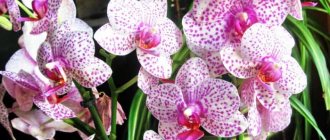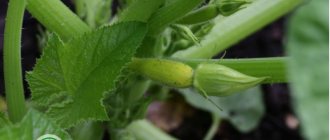Growing orchids in a closed system is an unusual technique, the popularity of which is due to its simplicity and efficiency. This method has its own characteristics, advantages and disadvantages. He is often criticized by conservative gardeners. However, if the technique were detrimental to orchids, it would not have received so many positive reviews from people who decided to use it. In order for an epiphytic plant to grow well in a pot without drainage holes, planting and care must be followed according to all the rules.
Advantages and disadvantages
There are many advantages of this method, and they look very attractive:
- Save time. Orchids planted in this way require a minimum of attention and caring for them is very simple - add water every 3-5 weeks and that’s it.
- Quick resuscitation of half-dead plants. At sales, orchids with rotten roots and no leaves are sold at a discount, and at first glance, getting them out seems hopeless. But after being placed in a closed system, they come to life, grow roots and even begin to bloom.
- Intensive growth of leaves and roots, as well as abundant long-term flowering.
- The closed system is ideal for growing orchids in dry climates. Plants growing in a container with water do not send out aerial roots, since they have enough moisture and do not need to look for it in the air.
- Protecting roots from rotting. Sphagnum moss, which is placed in a pot, has powerful disinfectant and antibacterial properties; this natural antibiotic gives flowers health.
Disadvantages arise from errors in care and non-compliance with planting rules:
- Rotting of the growing point or roots.
- The appearance of insects in the substrate.
- The occurrence of mold.
- Dried plants are difficult to transfer into a closed system.
- Not suitable for humid climates.
The growth of green algae on the walls of the container is also called a possible drawback, but this is a natural process that shows that its own biosystem has been established inside.
What difficulties may arise
Growing an orchid in a closed system has both pros and cons. The first reason why a plant may not grow well is that it was purchased from a non-specialized store. There is a high probability of buying a low-quality or diseased plant. We recommend purchasing plants from greenhouses or flower shops that provide conditions for their comfortable waiting for the owner.
Important!
The humidity that the orchid loves so much is also loved by pests. To avoid infection of the plant, you need to regularly inspect all its parts. If insects, fungus or plaque are detected, the flower will need to be treated with appropriate preparations.
Often the owner of an orchid is upset by the sudden cessation of flowering. This occurs due to lack of light and nutrients. Sudden temperature changes when changing the time of day also negatively affect the formation of peduncles.
You may be interested in: How to care for orchids in a pot after purchase Why the leaves of an orchid wither and how to save it Features of the care and propagation of the Dendrobium Nobile orchid
It happens that watering is not organized correctly, which causes the roots and neck of plants to rot. In this case, you will need to remove the orchid from the substrate and rinse the roots well. Then remove the rotten ones and dry the plant well for 4-6 days. The contents of the pot will need to be changed or washed and dried. If you plan to continue growing the orchid in a closed system, you will need to reconsider the watering regime.
A green coating inside the pot spoils the appearance of the entire composition. This is a sign that the system has formed. The only way to deal with this drawback is to remove the plant along with the substrate, wash the pot and put the system back. You will have to do this often.
Growing an orchid in a closed system is not difficult. This allows you to revive plants that have partially or completely lost their root system. The method has many advantages, so it finds many supporters.
Preparation
In order for the planting to be successful and the orchid to take root in a new place, you need to purchase everything you need in advance, and you should start with choosing a container.
Choosing the right container
It is better to take a glass container as a pot ; it is more stable than plastic, and it looks more beautiful.
In addition, glass does not have a porous structure, which prevents root ingrowth. The shape can be different, but round is undesirable, since if you need to replant the plant, pulling out the root system without damaging it will be problematic. The round flask will have to be broken. For children and orchids with small roots, all kinds of glasses, glasses and even beer mugs are suitable, it all depends on your imagination or what you have on hand.
Larger plants need a large capacity: multi-liter vases or even small aquariums in which several flowers can be planted at the same time. But you shouldn’t do this right away; it makes more sense to test a closed system on one plant.
Reference! You should choose a transparent vessel, this makes it easier to control the water level and observe what is happening inside.
You can find out more about orchid pots here.
Substrate
The substrate for planting in a closed container consists of several components that cannot be mixed, but must be laid in layers:
- expanded clay;
- sphagnum moss;
- bark or substrate for orchids;
- charcoal.
All this is sold in a flower shop, but bark and moss can be collected in the forest , if there is one nearby. Pieces of bark are preferably large, so that moist air can “walk” freely between them, and without traces of mold; they can also be successfully replaced with cones.
There is no need to boil, calcinate or disinfect anything; everything is poured into the container directly from the bags. It is advisable to purchase sphagnum moss alive, or when purchasing, choose one that has at least small green twigs; they will then come to life and the moss will grow.
You can find out more about soil for orchids here.
Orchid lovers may also like the following articles:
- about the Thai orchid;
- about growing a flower from seeds at home.
Conditions of detention and rules of care
Choosing the right place to grow an orchid is only half the battle. An important role is played by the planting container, the composition of the soil mixture, as well as the temperature conditions in the room.
Container for planting
For planting phalaenopsis it is allowed to use:
- plastic pot (necessarily transparent);
- clay pots;
- baskets;
- glass flowerpots (requires special soil and watering regime).
Some epiphytes can land on the block. A block is a piece of bark or wood into which miniature varieties of orchids or seedlings are planted. Be sure to use moss to prevent the roots from drying out.
If you decide to plant phalaenopsis in the classic way (in a regular flower pot), then familiarize yourself with the features of the planting container:
- The pot should be transparent (for example, plastic), since the root system of orchids needs a lot of light.
- The container must be wide enough so that the voluminous root system can grow in breadth without problems.
- Be sure to choose containers with drainage holes in the bottom and sides. If the purchased pot does not have them, then make them yourself using a burner (make the holes not too large, no more than 7 mm).
Video about what containers you can grow orchids in:
Substrate
The choice of substrate will depend on what type of phalaenopsis you are going to grow:
- If your orchid belongs to the epiphyte family, then the soil in this case will play a supporting role for the plant. It will hold the flower body in an upright position, protect the roots from stagnant moisture and ensure air exchange. It should contain fragments of tree bark, coal, cork material, moss, and granulated clay. And no garden soil! It will only retain liquid. You can add a little coarse sand.
- Terrestrial orchid species prefer the same soil as epiphytes, with the only difference being that they still need a small amount of garden soil and dry foliage. All components must be thoroughly crushed and a drainage layer placed on the bottom of the container.
- For beginners, it’s better not to think twice and purchase a ready-made mixture in a specialized store. This will help you avoid mistakes when mixing the soil yourself.
Video about the types of soil for growing orchids:
Temperature and humidity
Most varieties of orchids thrive at daytime temperatures of +18-27 degrees and at night temperatures of +13-24 degrees. But the difference between night and day temperatures plays an important role when growing these flowers.
If you have central heating, try moving a plant that is used to warm temperatures to a cooler location overnight. This can lead to good results and the appearance of new flower stalks.
As for humidity, everything is quite simple - you need to maintain a 60-80% humidity level in the room. If you are unable to achieve such high results, then try placing a tray with a grate under the pot with the plant, first pouring a little water into the bottom and covering everything with gravel.
Make sure that the roots do not touch the water during these manipulations. In drought and heat, you can spray orchids from a spray bottle. Just calculate the time - the plant should dry out by nightfall.
Step by Step Actions
- Pour expanded clay drainage into the bottom of a clean container , 3-4 centimeters.
- Then a layer of moss , one and a half centimeters wide.
- The next layer is bark mixed with coal or orchid substrate.
- Next, take the cleaned flower, straighten the roots and place it in a container . You definitely need to make sure that the neck does not go deep into the pot, but is on the surface, otherwise it will rot.
- Then carefully fill the container to the top with bark so that the orchid sits tightly in it and does not dangle.
- We lay a layer of moss on top , here it will serve as mulch and will protect moisture from intense evaporation.
- Then fill it to the top with warm water and after half an hour drain it , but not all of it, so that the bottom layer of expanded clay is completely covered with water.
That's it, landing in the closed system is over. Now all that remains is to place the plant in an area that corresponds to the correct lighting and temperature conditions, and add water as needed.
Important! The flower must be planted so that the roots do not reach the expanded clay with water.
This method is good because the roots are constantly in an optimally moist environment, and not an overly wet, or vice versa, dry environment.
You can read more about planting orchids here.
More detailed planting instructions in the video:
Closed system principle
In the wild, epiphytes have open roots. Therefore, orchids are traditionally planted in flowerpots with holes from which excess liquid flows out. Sudden fluctuations in temperature and humidity can cause stress, which causes the flower to stop growing. It is in a closed system that the most important environmental parameters are maintained at the same level. Its principle boils down to the fact that the plant is planted in a container without holes, pouring a little water.
Orchids planted in an isolated container grow roots towards the food source, i.e. down. Only the bottom is filled with liquid. Constant humidity promotes the development of a powerful root system and intensive growth of leaves and flower stalks. A layer of moss placed on top of the container prevents moisture evaporation. Even exposed root areas do not dry out. Despite the absence of drainage holes at the bottom, the liquid does not stagnate and the roots do not rot.
On a note! A closed system as a permanent growing area is suitable for healthy plants. Their vegetative mass and roots should be well developed. In this case, the risk of possible diseases and problems is reduced.
Plant adaptation
Their adaptation depends on the degree of impact on the root system. If the plant has undergone a radical operation to trim dry or rotten roots, it will have a hard time with replanting. To prevent this from happening, you need to adhere to simple rules, namely: the flower should be replanted when it is in the growth phase and at the same time leave part of the old substrate. There is no need to feed immediately, it will only do harm.
Also, during the adaptation period, the plant may dry out the lower leaves or drop flowers; this is a normal reaction of a flower getting used to its new place of residence.
Features of the phalaenopsis orchid
The phalaenopsis orchid belongs to the family of epiphytic plants. With its branched, tentacle-like roots, the flower in nature is attached to branches, tree bark, in crevices between stones, and on moss-covered rocks. Nutrition, moisture and ultraviolet light are absorbed by both leaves and roots. The plant loves warmth and humidity, because its homeland is in the tropics and subtropics. Found in regions of Southeast Asia, Australia, and the Philippines.
A flower can go without watering for a long time because it is able to absorb water from moist air through the mouths of leaves and aerial roots. For normal growth and long flowering, it needs a long day of light, at least 10-12 hours. In southern latitudes there is no dormant period; the flower grows very quickly all year round, producing 1.5-2 cm of green mass (roots, peduncles or leaves) per day.
Aftercare
for an orchid growing in a closed system is very simple; it includes watering and fertilizing . Spraying, immersing, bathing in the shower will be unnecessary, and as long as there are drops of condensation on the walls of the vessel, the plant does not need additional moisture at all. The watering itself works like this: water is poured in a thin stream until it covers the layer of expanded clay. This water level should be maintained constantly.
They begin to feed the orchid only after it has taken root and started growing. A flower living in a closed system requires very little fertilizer, 10 times less than indicated in the instructions. They can be applied either with each watering or every other time.
The main difficulties in cultivation
When cultivating orchids using this method, gardeners most often encounter mold. At first it almost always appears, but as the plants adapt, it disappears.
Insects often appear on a moist substrate and diseases develop. The fight against them involves both the use of traditional methods and the improvement of cultivation conditions and bringing them back to normal.
Gardeners often use excessively voluminous containers for cultivation, in which the plants dry out. This happens because the roots are too short to reach the water. This issue should be approached more carefully.
Difficulties and problems
- The most common problem is an overly large and deep vessel . The orchid simply dries out in it, since the roots are too far from moisture. Therefore, you should not take the container for growth.
- The next problem is mold . You shouldn’t be afraid of it; after the plant adapts and grows, it will disappear on its own.
- Fine substrate or pieces of bark often cause root rot, because rot perfectly absorbs and retains water. In addition, it clumps, becomes dense and does not allow air to pass through.
- Midges love moist substrate. First of all, you should find out the type of insects, the degree of their danger to orchids, and then choose the optimal method of combating them.
Flower growers will find the following articles about growing orchids useful to read:
- from an onion;
- from seeds purchased in China;
- in water.
Diseases and pests
Midges love moist substrate. The optimal insect repellent is dry mustard powder, which is sprinkled on top of the substrate.
If thrips and scale insects are found on a flower, treat it with one of the solutions (reducing the dosage):
- "Aktara";
- "Aktellik";
- "Fitoverm".
The treatment interval is 10 days, the number of sprays is 3-4.
If there is rotting of the roots and blackening of the leaves, this is a sign of powdery mildew, anthracnose or leaf spot. This plant cannot be treated.
When only the root rots, it is urgently removed from the substrate, washed with water, the rotten parts are cut off and dried for 4 days. Then completely change the substrate in the container and plant the flower back.
How long can flowers grow using this method?
Fans of the traditional method argue that the closed planting method can be used temporarily, only for the period of resuscitation of the plant or raising the baby. At the same time, many years of experience of other hobbyists shows that with proper care and compliance with all rules, orchids remain healthy and live in a closed system for many years.
Whatever planting method is chosen, you should always remember that any living organism needs attention and care, and a careless attitude will destroy even the strongest plant.
If you find an error, please select a piece of text and press Ctrl+Enter.
How not to water a plant?
To prevent the consequences of improper watering, you need to know how to moisturize an orchid:
- You should not pour water on the leaves, as keeping the liquid on the leaf plate for a long time will make the flowers faded and lethargic.
- Do not use too cold or hard water for irrigation. This will lead to the formation of yellow leaves and accelerated death of areas of the root system.
- When using the immersion method, do not use the same water for all plants. Otherwise, the presence of a certain disease in a specific flower can cause mass damage.
Transfer time
Transferring to another pot is a stressful situation for any plant. On what day to replant an orchid, gardeners decide based on the condition of the flower. But you should not carry out the procedure during flowering. The culture spends a lot of effort to form a peduncle, and any change in environmental conditions can be perceived as a negative factor.
There is no exact information about when to replant an orchid after flowering. There is no clear answer to this question in the specialized literature. But experienced flower growers recommend focusing on spring, when flower crops begin to grow.
Related article:
How to save an orchid from rotting
When deciding when to replant an orchid, you should take into account that it takes root well at any time of the year. But if we are talking about saving a flower from disease, it needs to be replanted immediately.











